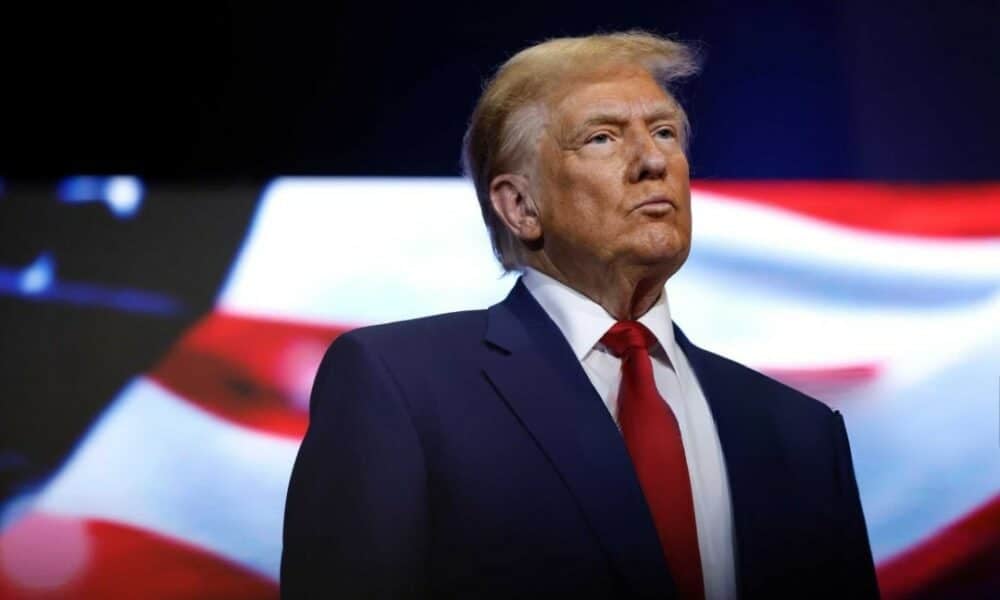Donald Trump, president of the United States, returned to the U.S. Congress on the evening of Tuesday, March 4, delivering his first official address to lawmakers in five years, exactly six weeks after taking office for his second term. The event, held in the House of Representatives chamber in Washington, DC, began at 11 p.m. Brasília time and was broadcast live by several outlets, including CNN, NBC, and Fox News. Unlike the traditional State of the Union address, this speech does not carry that formal title since presidents newly sworn in, as Trump was on January 20, typically reserve the term for later in their terms. Trump’s goal was evident: to outline his administration’s initial steps, defend controversial moves, and project his vision for the next four years amid a landscape of domestic and international challenges that have defined his early days in office.
The joint session of Congress, attended by senators and representatives, unfolded against a backdrop of heightened anticipation both in the U.S. and globally. Six weeks into his presidency, Trump has tackled a packed agenda, implementing tariffs on Mexico and Canada, halting arms shipments to Ukraine, and pushing measures to shrink federal bureaucracy. The address, lasting over an hour, provided the Republican a platform to reinforce his campaign narrative of “restoring America’s greatness,” a cornerstone of his 2024 election victory over Democrat Kamala Harris, where he secured 277 Electoral College votes.
Thousands watched the proceedings, both in person at the Capitol and via live broadcasts, as political analysts and citizens awaited insights into how Trump plans to address pressing issues like the war in Ukraine, negotiations with Hamas, and the migrant surge at the U.S.-Mexico border. The presence of key figures such as Vice President J.D. Vance and House Speaker Mike Johnson underscored the moment’s significance, occurring as Trump’s approval ratings show early signs of decline, though he insists he holds a “resounding mandate” from the American people.
A stage for promises and controversies
Trump’s Capitol comeback
Five years after his last congressional address in 2019 during his first term, Donald Trump took the podium in the House chamber with a confident demeanor, aiming to reassert his leadership. Sworn in as the 47th U.S. president on January 20, he opened the speech by echoing bold statements from his inauguration, such as “America’s golden age starts now.” The event followed weeks of polarizing actions, including signing dozens of executive orders on his first day, targeting immigration and reversing environmental policies from Joe Biden’s administration. The choice of the Capitol as the venue was more than symbolic—it was a political power play in a building that, on January 6, 2021, saw an invasion by his supporters attempting to block Biden’s election certification.
On that chilly March evening, with temperatures dipping below 40°F in Washington, the ceremony took place indoors at the Capitol Rotunda rather than the usual National Mall, a shift driven by weather and logistics. Trump seized the occasion to tout early wins, such as the Israel-Hamas ceasefire mediated by Qatar, Egypt, and the U.S. under Biden, which he claimed as a result of his sway over Israeli Prime Minister Benjamin Netanyahu. The war in Ukraine also featured prominently, with Trump hinting at ongoing talks with Russia, following threats to escalate sanctions if the conflict doesn’t resolve swiftly.
Core themes of the address
Over the course of more than an hour, Trump covered a broad array of topics dominating his agenda since January. Shrinking federal bureaucracy was a standout pledge, with the president vowing to cut spending and eliminate regulations he says stifle the American economy. He also took jabs at the Biden administration, claiming, “In four days, I’ve done more than the last government did in four years.” Immigration, a recurring theme in his political career, took center stage as he reaffirmed a national emergency at the Mexican border, a move authorizing military funds for a border wall—a promise revived from his first term.
Foreign policy was another focus, with Trump championing tariffs as a pressure tactic. He defended taxing foreign nations to “enrich American citizens,” spotlighting talks with Mexico and Canada that could yield an agreement this week. The Ukraine war and the release of hostages in Gaza were cited as examples of his intent to act as a “peacemaker,” though specifics on these efforts remained vague. His messianic tone, evident at his inauguration, resurfaced as he claimed to have been “saved by God” to lead the U.S., referencing a 2024 campaign assassination attempt where a bullet grazed his ear at a Pennsylvania rally.
Early moves of a presidency under scrutiny
Six weeks of bold action
Six weeks into his second term, Trump’s administration has been defined by an aggressive, unilateral approach. On his first day, January 20, he signed dozens of executive orders at a public event in Capital One Arena, overturning 78 Biden-era actions, exiting the Paris Climate Accord for the second time, and pardoning roughly 1,500 supporters convicted in the 2021 Capitol riot. These moves, showcased with flair as Trump tossed signing pens into the crowd, signaled a government intent on swift action, often bypassing Congress, sparking debates over presidential authority limits.
Immigration policy marked another early milestone. Beyond the border emergency, Trump labeled Mexican cartels as terrorist organizations, broadening the scope of operations against them, and invoked the 1798 Alien Enemies Act to crack down on foreign gangs in the U.S. Economically, he scrapped the Green New Deal and electric vehicle mandates, aiming to protect American automakers, particularly in swing states like Michigan and Ohio that clinched his electoral win. His push to ramp up oil and gas production was also emphasized, targeting lower energy costs and inflation, which he blames on Biden’s “reckless spending.”
Timeline of Trump’s key actions
Trump’s second term kicked off with a flurry of decisions setting his administration’s tone. Here’s a rundown of major milestones leading up to the congressional speech:
- January 20: Inauguration at the Capitol and initial executive orders, including the border emergency and environmental policy rollbacks.
- January 22: Announcement of the Israel-Hamas ceasefire, with Trump taking credit for pressuring Netanyahu.
- January 25: Tariffs imposed on Mexico and Canada, prompting responses from leaders like Justin Trudeau and Andrés Manuel López Obrador.
- March 4: First congressional address, recapping 45 days in office and outlining next steps.
These rapid moves, while decisive, have drawn criticism. Halting arms to Ukraine after a tense meeting with President Volodymyr Zelensky raised NATO allies’ concerns, while tariffs reignited fears of a trade war with North American neighbors.
Public and political response
Trump’s popularity, which soared during the campaign, shows signs of erosion. Recent polls reflect declining approval ratings, particularly after the Ukraine aid pause and tariffs that could hike imported goods prices. In Congress, reactions split along party lines: Republicans like Mike Johnson gave standing ovations, while Democrats sat silently at key moments, highlighting persistent national division. Outside the Capitol, supporters filled Capital One Arena to watch the broadcast, but protests against his immigration and environmental policies also flared in Washington.
What lies ahead in the coming months
Plans for the near future
With the speech, Trump sketched an ambitious roadmap for the coming months, vowing to fast-track his reforms. Federal bureaucracy cuts will intensify with a hiring freeze and mandatory in-person work for public servants, policies already active since January. In foreign policy, he reiterated plans to “reclaim control” of the Panama Canal—a contentious idea lacking specifics—and plant the American flag on Mars, echoing his campaign’s expansive rhetoric. Taxing foreign nations to fund the U.S., rather than its citizens, was also highlighted, with looming Mexico-Canada talks serving as a critical test.
Domestically, Trump pledged to tackle inflation via a “national energy emergency,” boosting oil and gas output to lower costs. Education and public health, slammed as inefficient in his speech, face overhauls, though concrete plans remain undisclosed. Freeing hostages in Gaza and ending the Ukraine war were framed as priorities, but analysts note the lack of clarity on execution could frustrate allies and voters alike.
Key measures announced in the speech
Trump outlined short-term actions during the address. Here are some highlights:
- Strengthened border wall construction using military funds.
- Expanded tariffs on nations “exploiting” the U.S. economically.
- Increased oil and gas exploration to cut energy prices.
- Review of federal diversity and inclusion policies.
- Push for a swift Ukraine deal, with threats of Russian sanctions.
These proposals, many aligned with the Heritage Foundation’s Project 2025, signal a focus on deregulation and protectionism, though they may face congressional and legal pushback.
Challenges on the horizon
Despite the upbeat tone, Trump faces significant hurdles. The legality of some executive orders, like military funding for the wall, is under scrutiny, while exiting the Paris Accord and WHO reignites debates over U.S. global leadership. Ties with allies like the European Union, criticized by Trump at January’s World Economic Forum, may worsen with tariffs. Domestically, political polarization and protests against his policies point to a rocky term, while slipping approval ratings pressure his ability to deliver on lofty promises like America’s “golden age.”

Donald Trump, president of the United States, returned to the U.S. Congress on the evening of Tuesday, March 4, delivering his first official address to lawmakers in five years, exactly six weeks after taking office for his second term. The event, held in the House of Representatives chamber in Washington, DC, began at 11 p.m. Brasília time and was broadcast live by several outlets, including CNN, NBC, and Fox News. Unlike the traditional State of the Union address, this speech does not carry that formal title since presidents newly sworn in, as Trump was on January 20, typically reserve the term for later in their terms. Trump’s goal was evident: to outline his administration’s initial steps, defend controversial moves, and project his vision for the next four years amid a landscape of domestic and international challenges that have defined his early days in office.
The joint session of Congress, attended by senators and representatives, unfolded against a backdrop of heightened anticipation both in the U.S. and globally. Six weeks into his presidency, Trump has tackled a packed agenda, implementing tariffs on Mexico and Canada, halting arms shipments to Ukraine, and pushing measures to shrink federal bureaucracy. The address, lasting over an hour, provided the Republican a platform to reinforce his campaign narrative of “restoring America’s greatness,” a cornerstone of his 2024 election victory over Democrat Kamala Harris, where he secured 277 Electoral College votes.
Thousands watched the proceedings, both in person at the Capitol and via live broadcasts, as political analysts and citizens awaited insights into how Trump plans to address pressing issues like the war in Ukraine, negotiations with Hamas, and the migrant surge at the U.S.-Mexico border. The presence of key figures such as Vice President J.D. Vance and House Speaker Mike Johnson underscored the moment’s significance, occurring as Trump’s approval ratings show early signs of decline, though he insists he holds a “resounding mandate” from the American people.
A stage for promises and controversies
Trump’s Capitol comeback
Five years after his last congressional address in 2019 during his first term, Donald Trump took the podium in the House chamber with a confident demeanor, aiming to reassert his leadership. Sworn in as the 47th U.S. president on January 20, he opened the speech by echoing bold statements from his inauguration, such as “America’s golden age starts now.” The event followed weeks of polarizing actions, including signing dozens of executive orders on his first day, targeting immigration and reversing environmental policies from Joe Biden’s administration. The choice of the Capitol as the venue was more than symbolic—it was a political power play in a building that, on January 6, 2021, saw an invasion by his supporters attempting to block Biden’s election certification.
On that chilly March evening, with temperatures dipping below 40°F in Washington, the ceremony took place indoors at the Capitol Rotunda rather than the usual National Mall, a shift driven by weather and logistics. Trump seized the occasion to tout early wins, such as the Israel-Hamas ceasefire mediated by Qatar, Egypt, and the U.S. under Biden, which he claimed as a result of his sway over Israeli Prime Minister Benjamin Netanyahu. The war in Ukraine also featured prominently, with Trump hinting at ongoing talks with Russia, following threats to escalate sanctions if the conflict doesn’t resolve swiftly.
Core themes of the address
Over the course of more than an hour, Trump covered a broad array of topics dominating his agenda since January. Shrinking federal bureaucracy was a standout pledge, with the president vowing to cut spending and eliminate regulations he says stifle the American economy. He also took jabs at the Biden administration, claiming, “In four days, I’ve done more than the last government did in four years.” Immigration, a recurring theme in his political career, took center stage as he reaffirmed a national emergency at the Mexican border, a move authorizing military funds for a border wall—a promise revived from his first term.
Foreign policy was another focus, with Trump championing tariffs as a pressure tactic. He defended taxing foreign nations to “enrich American citizens,” spotlighting talks with Mexico and Canada that could yield an agreement this week. The Ukraine war and the release of hostages in Gaza were cited as examples of his intent to act as a “peacemaker,” though specifics on these efforts remained vague. His messianic tone, evident at his inauguration, resurfaced as he claimed to have been “saved by God” to lead the U.S., referencing a 2024 campaign assassination attempt where a bullet grazed his ear at a Pennsylvania rally.
Early moves of a presidency under scrutiny
Six weeks of bold action
Six weeks into his second term, Trump’s administration has been defined by an aggressive, unilateral approach. On his first day, January 20, he signed dozens of executive orders at a public event in Capital One Arena, overturning 78 Biden-era actions, exiting the Paris Climate Accord for the second time, and pardoning roughly 1,500 supporters convicted in the 2021 Capitol riot. These moves, showcased with flair as Trump tossed signing pens into the crowd, signaled a government intent on swift action, often bypassing Congress, sparking debates over presidential authority limits.
Immigration policy marked another early milestone. Beyond the border emergency, Trump labeled Mexican cartels as terrorist organizations, broadening the scope of operations against them, and invoked the 1798 Alien Enemies Act to crack down on foreign gangs in the U.S. Economically, he scrapped the Green New Deal and electric vehicle mandates, aiming to protect American automakers, particularly in swing states like Michigan and Ohio that clinched his electoral win. His push to ramp up oil and gas production was also emphasized, targeting lower energy costs and inflation, which he blames on Biden’s “reckless spending.”
Timeline of Trump’s key actions
Trump’s second term kicked off with a flurry of decisions setting his administration’s tone. Here’s a rundown of major milestones leading up to the congressional speech:
- January 20: Inauguration at the Capitol and initial executive orders, including the border emergency and environmental policy rollbacks.
- January 22: Announcement of the Israel-Hamas ceasefire, with Trump taking credit for pressuring Netanyahu.
- January 25: Tariffs imposed on Mexico and Canada, prompting responses from leaders like Justin Trudeau and Andrés Manuel López Obrador.
- March 4: First congressional address, recapping 45 days in office and outlining next steps.
These rapid moves, while decisive, have drawn criticism. Halting arms to Ukraine after a tense meeting with President Volodymyr Zelensky raised NATO allies’ concerns, while tariffs reignited fears of a trade war with North American neighbors.
Public and political response
Trump’s popularity, which soared during the campaign, shows signs of erosion. Recent polls reflect declining approval ratings, particularly after the Ukraine aid pause and tariffs that could hike imported goods prices. In Congress, reactions split along party lines: Republicans like Mike Johnson gave standing ovations, while Democrats sat silently at key moments, highlighting persistent national division. Outside the Capitol, supporters filled Capital One Arena to watch the broadcast, but protests against his immigration and environmental policies also flared in Washington.
What lies ahead in the coming months
Plans for the near future
With the speech, Trump sketched an ambitious roadmap for the coming months, vowing to fast-track his reforms. Federal bureaucracy cuts will intensify with a hiring freeze and mandatory in-person work for public servants, policies already active since January. In foreign policy, he reiterated plans to “reclaim control” of the Panama Canal—a contentious idea lacking specifics—and plant the American flag on Mars, echoing his campaign’s expansive rhetoric. Taxing foreign nations to fund the U.S., rather than its citizens, was also highlighted, with looming Mexico-Canada talks serving as a critical test.
Domestically, Trump pledged to tackle inflation via a “national energy emergency,” boosting oil and gas output to lower costs. Education and public health, slammed as inefficient in his speech, face overhauls, though concrete plans remain undisclosed. Freeing hostages in Gaza and ending the Ukraine war were framed as priorities, but analysts note the lack of clarity on execution could frustrate allies and voters alike.
Key measures announced in the speech
Trump outlined short-term actions during the address. Here are some highlights:
- Strengthened border wall construction using military funds.
- Expanded tariffs on nations “exploiting” the U.S. economically.
- Increased oil and gas exploration to cut energy prices.
- Review of federal diversity and inclusion policies.
- Push for a swift Ukraine deal, with threats of Russian sanctions.
These proposals, many aligned with the Heritage Foundation’s Project 2025, signal a focus on deregulation and protectionism, though they may face congressional and legal pushback.
Challenges on the horizon
Despite the upbeat tone, Trump faces significant hurdles. The legality of some executive orders, like military funding for the wall, is under scrutiny, while exiting the Paris Accord and WHO reignites debates over U.S. global leadership. Ties with allies like the European Union, criticized by Trump at January’s World Economic Forum, may worsen with tariffs. Domestically, political polarization and protests against his policies point to a rocky term, while slipping approval ratings pressure his ability to deliver on lofty promises like America’s “golden age.”







